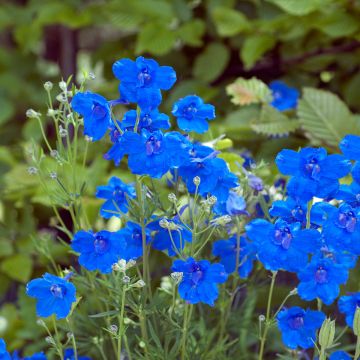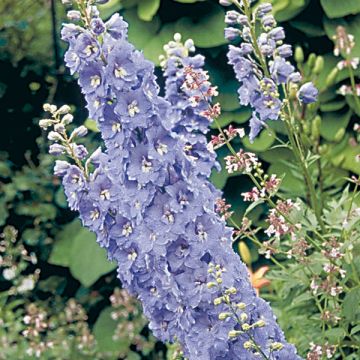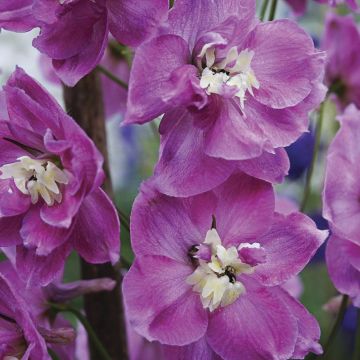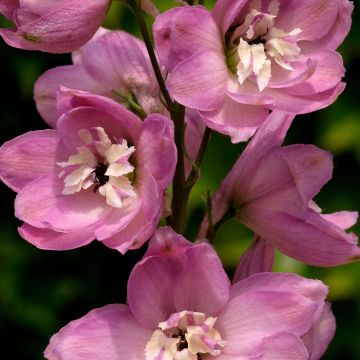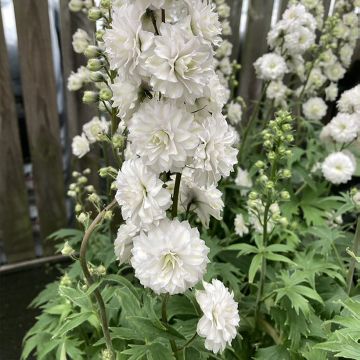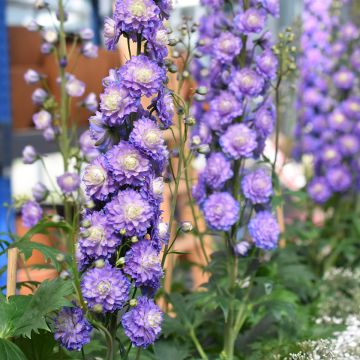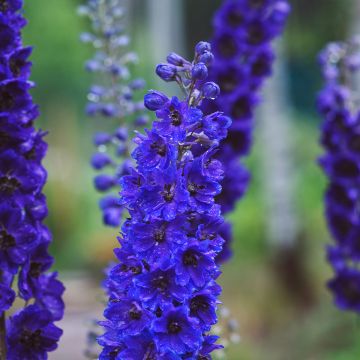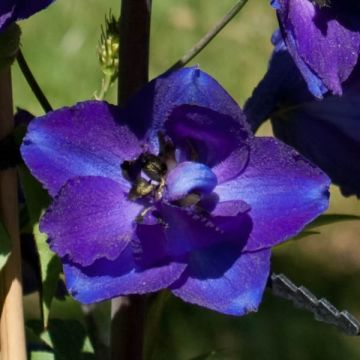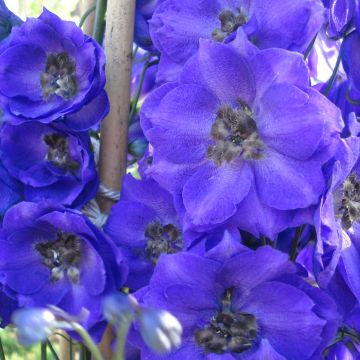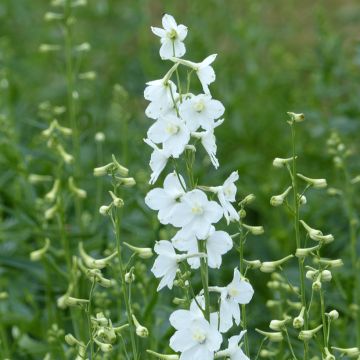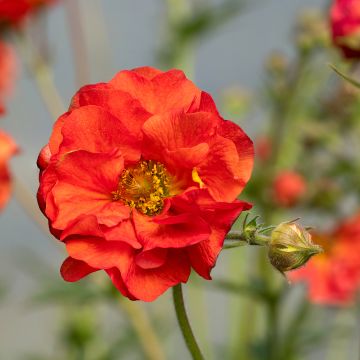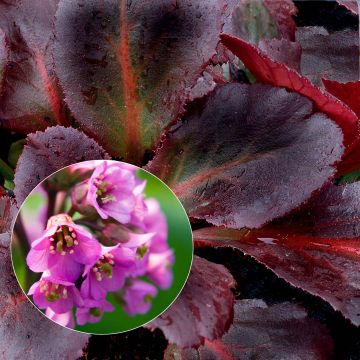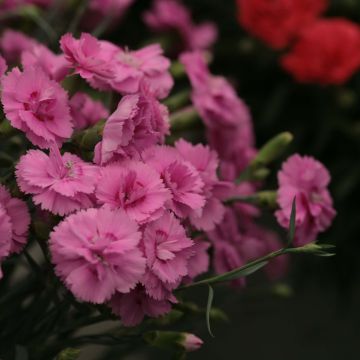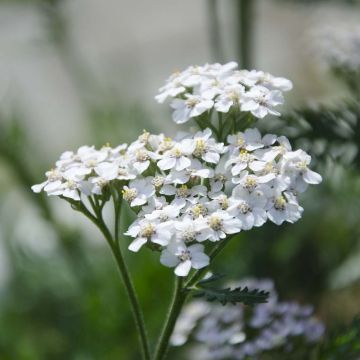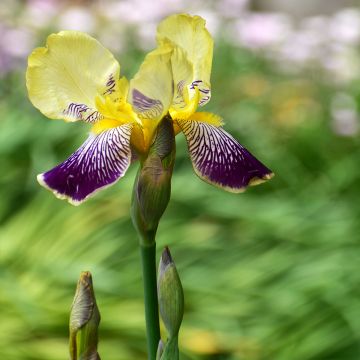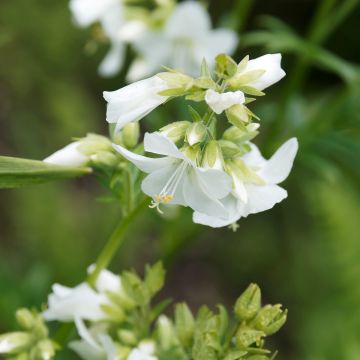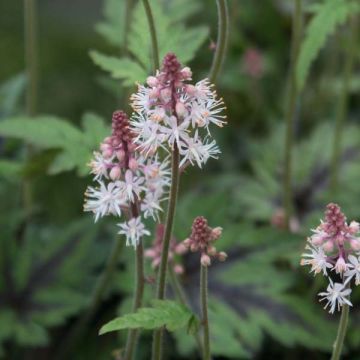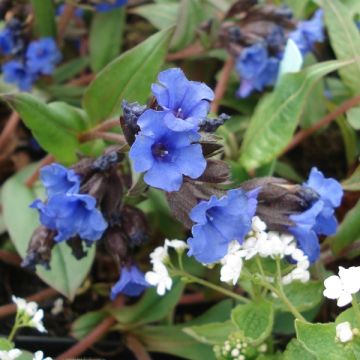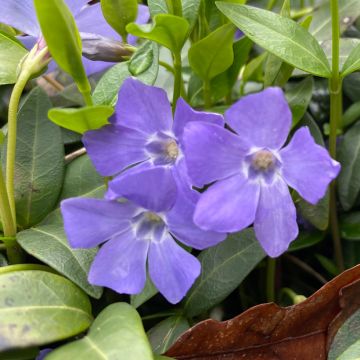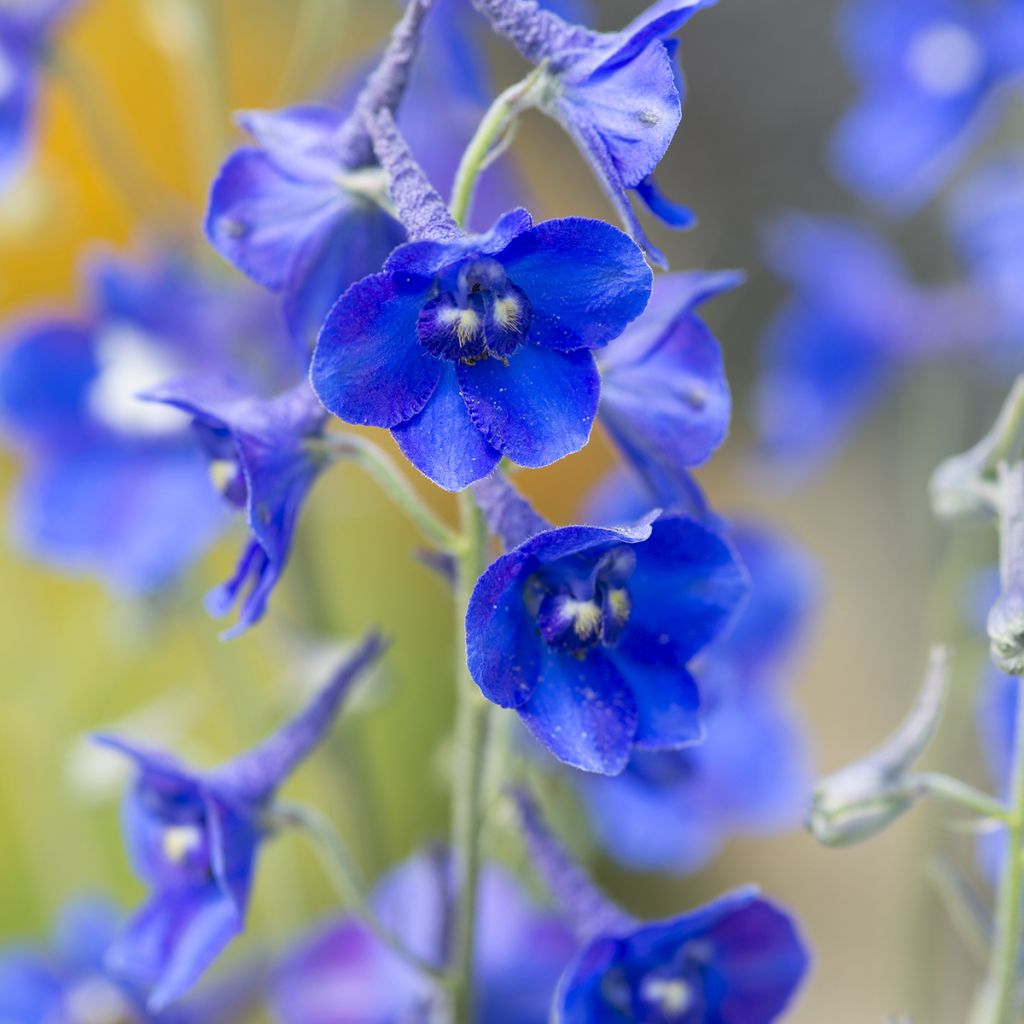

Delphinium Belladonna Oriental Blue - Candle Larkspur seeds
Delphinium Belladonna Oriental Blue - Candle Larkspur seeds
Delphinium (x) belladonna Volkerfrieden Oriental Blue
Belladonna Delphinium, Belladonna Larkspur
This item cannot be shipped to the selected country
Dispatch by letter from €3.90
More information
Schedule delivery date,
and select date in basket
This plant carries a 6 months recovery warranty
More information
We guarantee the quality of our plants for a full growing cycle, and will replace at our expense any plant that fails to recover under normal climatic and planting conditions.
Seed-only orders are dispatched by sealed envelope. The delivery charge for seed-only orders is €3.90.
Does this plant fit my garden?
Set up your Plantfit profile →
Description
Delphinium (Belladonna Group) Oriental Blue is a perennial selection derived from the 'Völkerfrieden' variety. It is not a giant so it does not necessarily require staking and shows good disease resistance. Its branches are quite loose and its clusters of flowers are sparse, but they are a vibrant electric gentian blue that does not fade over time. This larkspur blooms in the first year. Its flowering period is long and can extend from June to October. Use the blooms for cut flowers.
Delphinium belladonna is a plant in the Ranunculaceae family belonging to a group of perennial varieties obtained by cross-breeding Delphinium elatum and Delphinium grandiflorum. 'Völkerfrieden Oriental Blue' reaches up to 1.30 m (4ft) high when in bloom, under optimal growing conditions, in rich soil with regular watering and feeding. In ordinary soil, with minimal care, it reaches a height of 70-80 cm (28-32in), so it will be fine without staking in sheltered locations. Flowering stems emerge from a clump of large, palmate and finely divided leaves, first in June-July and again in September-October, if you remove the faded stems as they appear. This variety produces slightly loose, 30 cm (12in) long, branched spikes adorned with small, 4 cm (2in) in diameter, single, graceful and lightweight flowers with a five-petaled corolla and a slightly swollen spur. They are a deep, electric, vibrant gentian blue. The plant develops from a woody rhizome that vertically penetrates the soil, which should be loose and deep enough to accommodate it.
Delphiniums prefer moist and fertile soils, but they do not want their roots in heavy and waterlogged soil. They do not mind harsh winters and enjoy being in the sun. If you provide these conditions, you will find them again every year. 'Oriental Blue' is of modest size compared to its giant cousins, offers less resistance to the wind and can lean on neighbouring plants. Its clusters are also less dense and more flexible, so its stems are less likely to break. Its intense blue brightens up summer borders, especially in contrast with plants with green-yellow foliage or flowers. Consider using lady's mantle, grasses, and other vertical plants like foxgloves or lupins. Its structure makes it a lightweight delphinium, ideal with shrubby plants like roses or peonies.
Note: From March to September, the stems of our delphiniums are pruned short to encourage better branching of the crown and achieve optimal rooting. This also prevents the stems from breaking during transport.
Report an error about the product description
Flowering
Foliage
Plant habit
Safety measures
Botanical data
Delphinium
(x) belladonna
Volkerfrieden Oriental Blue
Ranunculaceae
Belladonna Delphinium, Belladonna Larkspur
Cultivar or hybrid
ingestion
Cette plante est toxique si elle est ingérée volontairement ou involontairement.
Ne la plantez pas là où de jeunes enfants peuvent évoluer, et lavez-vous les mains après l'avoir manipulée.
Pensez à conserver l'étiquette de la plante, à la photographier ou à noter son nom, afin de faciliter le travail des professionnels de santé.
Davantage d'informations sur https://plantes-risque.info
Other Delphinium - Larkspur
Planting and care
Sow Delphinium seeds directly outdoors, from April to May, in full sun, on a fertile, light, well-drained, previously well-prepared soil. Bury the fine seeds at a depth of 6 mm (0in) in small holes 30 cm (12in) apart. Keep the soil moist by watering regularly, especially during dry periods. Germination usually takes 14 to 21 days. When the seedlings are large enough to handle, thin out to one plant every 15 cm (6in).
For earlier flowering, sow the Delphinium seeds from August to October in 7.5 cm (3in) pots of good quality compost, kept moist. Place the pots in a propagator or inside a plastic bag at a temperature of 15-20 °C (59-68°F) until germination. Once the seedlings have developed, move them to a bright, but cooler location. Overwinter the plants in a cool, bright place, protected from frost, watering them sparingly. Transplant them to their final location the following spring. Water regularly until the plants are fully established.
Remove faded flowers to encourage the renewal of flowering. Delphiniums thrive in sunny locations, protected from the wind, and in fertile soil, rich in organic matter and well-drained. Soil that is too wet or too dry is detrimental to the growth and flowering duration of the larkspur.
Delphinium belladonna 'Völkerfrieden Oriental Blue' can be planted in spring or autumn, either in the ground or in a pot. Make sure the pot is large enough to accommodate it (50 cm (20in) x 50 cm (20in)) and keep it away from strong winds. Delphiniums are easy to grow but have certain essential requirements: they dislike heavy and damp soils, as well as dry and poor soils. The soil that suits them is rich in humus, not compacted, moist, even in summer, but not waterlogged in winter. They also like to be in the sun.
The hybrid belladonna Delphiniums allow us to enjoy these plants where we expect them, for several years, without the daily distribution of slug repellents.
Sowing period
Intended location
This item has not been reviewed yet - be the first to leave a review about it.
Spring flowering perennials
Haven't found what you were looking for?
Hardiness is the lowest winter temperature a plant can endure without suffering serious damage or even dying. However, hardiness is affected by location (a sheltered area, such as a patio), protection (winter cover) and soil type (hardiness is improved by well-drained soil).

Photo Sharing Terms & Conditions
In order to encourage gardeners to interact and share their experiences, Promesse de fleurs offers various media enabling content to be uploaded onto its Site - in particular via the ‘Photo sharing’ module.
The User agrees to refrain from:
- Posting any content that is illegal, prejudicial, insulting, racist, inciteful to hatred, revisionist, contrary to public decency, that infringes on privacy or on the privacy rights of third parties, in particular the publicity rights of persons and goods, intellectual property rights, or the right to privacy.
- Submitting content on behalf of a third party;
- Impersonate the identity of a third party and/or publish any personal information about a third party;
In general, the User undertakes to refrain from any unethical behaviour.
All Content (in particular text, comments, files, images, photos, videos, creative works, etc.), which may be subject to property or intellectual property rights, image or other private rights, shall remain the property of the User, subject to the limited rights granted by the terms of the licence granted by Promesse de fleurs as stated below. Users are at liberty to publish or not to publish such Content on the Site, notably via the ‘Photo Sharing’ facility, and accept that this Content shall be made public and freely accessible, notably on the Internet.
Users further acknowledge, undertake to have ,and guarantee that they hold all necessary rights and permissions to publish such material on the Site, in particular with regard to the legislation in force pertaining to any privacy, property, intellectual property, image, or contractual rights, or rights of any other nature. By publishing such Content on the Site, Users acknowledge accepting full liability as publishers of the Content within the meaning of the law, and grant Promesse de fleurs, free of charge, an inclusive, worldwide licence for the said Content for the entire duration of its publication, including all reproduction, representation, up/downloading, displaying, performing, transmission, and storage rights.
Users also grant permission for their name to be linked to the Content and accept that this link may not always be made available.
By engaging in posting material, Users consent to their Content becoming automatically accessible on the Internet, in particular on other sites and/or blogs and/or web pages of the Promesse de fleurs site, including in particular social pages and the Promesse de fleurs catalogue.
Users may secure the removal of entrusted content free of charge by issuing a simple request via our contact form.
The flowering period indicated on our website applies to countries and regions located in USDA zone 8 (France, the United Kingdom, Ireland, the Netherlands, etc.)
It will vary according to where you live:
- In zones 9 to 10 (Italy, Spain, Greece, etc.), flowering will occur about 2 to 4 weeks earlier.
- In zones 6 to 7 (Germany, Poland, Slovenia, and lower mountainous regions), flowering will be delayed by 2 to 3 weeks.
- In zone 5 (Central Europe, Scandinavia), blooming will be delayed by 3 to 5 weeks.
In temperate climates, pruning of spring-flowering shrubs (forsythia, spireas, etc.) should be done just after flowering.
Pruning of summer-flowering shrubs (Indian Lilac, Perovskia, etc.) can be done in winter or spring.
In cold regions as well as with frost-sensitive plants, avoid pruning too early when severe frosts may still occur.
The planting period indicated on our website applies to countries and regions located in USDA zone 8 (France, United Kingdom, Ireland, Netherlands).
It will vary according to where you live:
- In Mediterranean zones (Marseille, Madrid, Milan, etc.), autumn and winter are the best planting periods.
- In continental zones (Strasbourg, Munich, Vienna, etc.), delay planting by 2 to 3 weeks in spring and bring it forward by 2 to 4 weeks in autumn.
- In mountainous regions (the Alps, Pyrenees, Carpathians, etc.), it is best to plant in late spring (May-June) or late summer (August-September).
The harvesting period indicated on our website applies to countries and regions in USDA zone 8 (France, England, Ireland, the Netherlands).
In colder areas (Scandinavia, Poland, Austria...) fruit and vegetable harvests are likely to be delayed by 3-4 weeks.
In warmer areas (Italy, Spain, Greece, etc.), harvesting will probably take place earlier, depending on weather conditions.
The sowing periods indicated on our website apply to countries and regions within USDA Zone 8 (France, UK, Ireland, Netherlands).
In colder areas (Scandinavia, Poland, Austria...), delay any outdoor sowing by 3-4 weeks, or sow under glass.
In warmer climes (Italy, Spain, Greece, etc.), bring outdoor sowing forward by a few weeks.

































